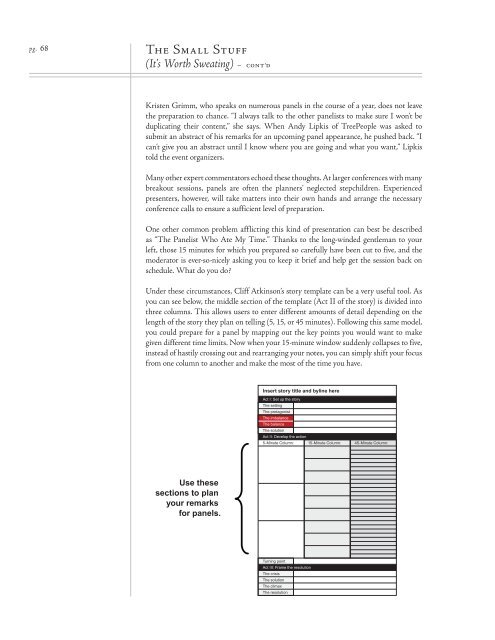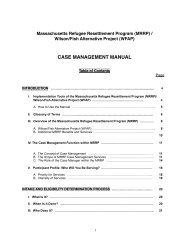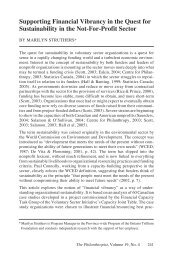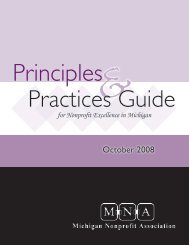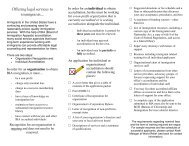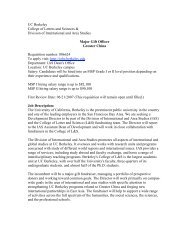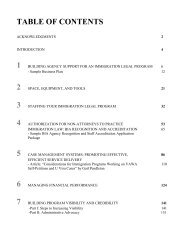Why Bad Presentations Happen to Good Causes - The Goodman ...
Why Bad Presentations Happen to Good Causes - The Goodman ...
Why Bad Presentations Happen to Good Causes - The Goodman ...
You also want an ePaper? Increase the reach of your titles
YUMPU automatically turns print PDFs into web optimized ePapers that Google loves.
pg. 68<br />
<strong>The</strong> Small Stuff<br />
(It’s Worth Sweating) – cont’d<br />
Kristen Grimm, who speaks on numerous panels in the course of a year, does not leave<br />
the preparation <strong>to</strong> chance. “I always talk <strong>to</strong> the other panelists <strong>to</strong> make sure I won’t be<br />
duplicating their content,” she says. When Andy Lipkis of TreePeople was asked <strong>to</strong><br />
submit an abstract of his remarks for an upcoming panel appearance, he pushed back. “I<br />
can’t give you an abstract until I know where you are going and what you want,” Lipkis<br />
<strong>to</strong>ld the event organizers.<br />
Many other expert commenta<strong>to</strong>rs echoed these thoughts. At larger conferences with many<br />
breakout sessions, panels are often the planners’ neglected stepchildren. Experienced<br />
presenters, however, will take matters in<strong>to</strong> their own hands and arrange the necessary<br />
conference calls <strong>to</strong> ensure a sufficient level of preparation.<br />
One other common problem afflicting this kind of presentation can best be described<br />
as “<strong>The</strong> Panelist Who Ate My Time.” Thanks <strong>to</strong> the long-winded gentleman <strong>to</strong> your<br />
left, those 15 minutes for which you prepared so carefully have been cut <strong>to</strong> five, and the<br />
modera<strong>to</strong>r is ever-so-nicely asking you <strong>to</strong> keep it brief and help get the session back on<br />
schedule. What do you do?<br />
Under these circumstances, Cliff Atkinson’s s<strong>to</strong>ry template can be a very useful <strong>to</strong>ol. As<br />
you can see below, the middle section of the template (Act II of the s<strong>to</strong>ry) is divided in<strong>to</strong><br />
three columns. This allows users <strong>to</strong> enter different amounts of detail depending on the<br />
length of the s<strong>to</strong>ry they plan on telling (5, 15, or 45 minutes). Following this same model,<br />
you could prepare for a panel by mapping out the key points you would want <strong>to</strong> make<br />
given different time limits. Now when your 15-minute window suddenly collapses <strong>to</strong> five,<br />
instead of hastily crossing out and rearranging your notes, you can simply shift your focus<br />
from one column <strong>to</strong> another and make the most of the time you have.<br />
Use these<br />
sections <strong>to</strong> plan<br />
your remarks<br />
for panels.<br />
Insert s<strong>to</strong>ry title and byline here<br />
Act I: Set up the s<strong>to</strong>ry<br />
<strong>The</strong> setting<br />
<strong>The</strong> protagonist<br />
<strong>The</strong> imbalance<br />
<strong>The</strong> balance<br />
<strong>The</strong> solution<br />
Act II: Develop the action<br />
5-Minute Column: 15-Minute Column: 45-Minute Column:<br />
Turning point<br />
Act III: Frame the resolution<br />
<strong>The</strong> crisis<br />
<strong>The</strong> solution<br />
<strong>The</strong> climax<br />
<strong>The</strong> resolution


